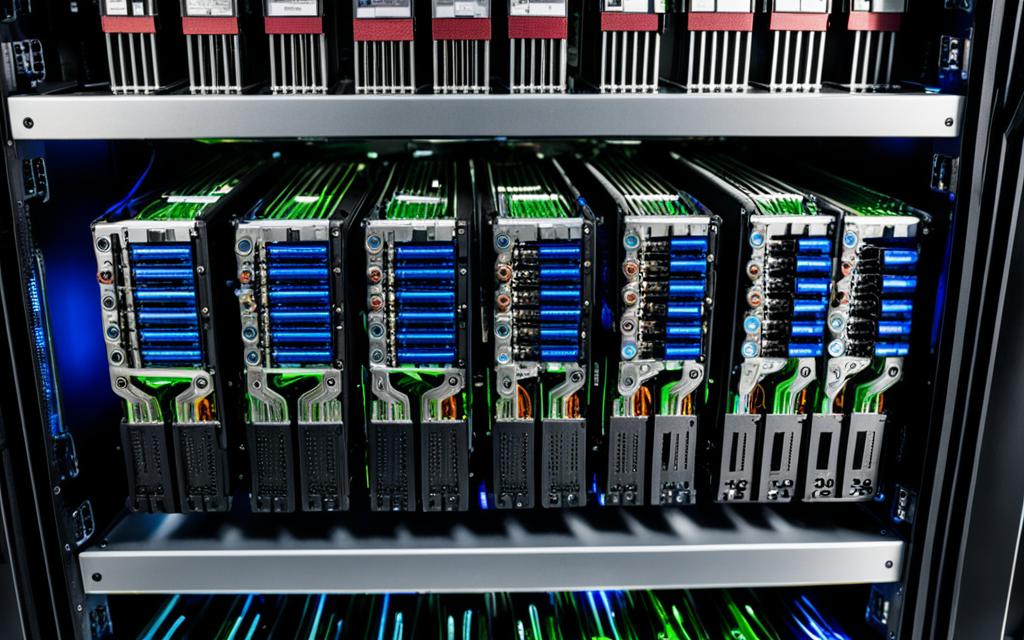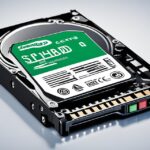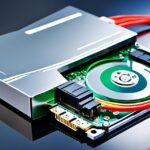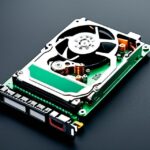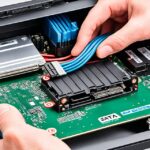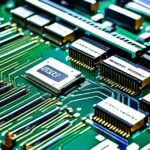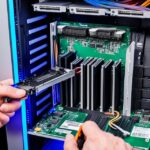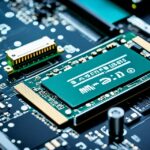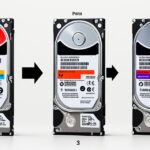Table of Contents
There are several key points to consider when figuring out how many HDDs a PC can handle. The capacity for hard drives is influenced not just by the drives themselves. It also depends on the motherboard’s design, the size of the case, and the power supply abilities.
Most motherboards are fitted with 4 to 6 SATA slots. This allows for the addition of about four to six hard drives in most cases1. Also, knowing the difference between MBR and GPT formats is vital. This knowledge impacts HDD capacity and how well it works1.
If you’re looking to expand your PC’s storage, this guide is perfect for you. It highlights the best setup to fully use your system’s capabilities. Whether you want to improve your gaming, handle lots of video content, or ensure your data is safe through redundancy, mastering HDD functionality is key. For tips on improving productivity and hardware use, check out our multiple monitors setup guide
Key Takeaways
- The maximum number of hard drives a typical PC can accommodate is usually up to four.
- Motherboards with additional SATA slots enable the addition of several hard drives.
- Using multiple hard drives enhances storage capacity for large files like games and videos.
- Address space limitations due to the operating system can restrict HDD usage significantly.
- Considerations must be made for power supply requirements when integrating new hard drives.
- PC case size plays a crucial role in determining how many drives can be physically mounted.
- Utilising multiple hard drives can lead to better data redundancy and security.
Understanding the Impact of Motherboard Limitations
The design and power of a motherboard greatly influence a PC’s storage abilities. Its SATA slots are crucial for how many drives you can connect. Most motherboards have 4 to 6 SATA slots for HDDs or SSDs. As SATA drives have speeds from 30 to 150 MB/s, choosing the right ones is key for your system’s speed2.
Available SATA Slots
SATA slots are key for hooking up HDDs. When you need more storage, the number of these slots matters a lot. Before adding or upgrading, check how many slots your motherboard has. Though 20 HDDs might fit using RAID in a JBOD enclosure, setups with 10 or 12 drives can be pricey3. For cheaper upgrades, consider a multi-SATA expansion card instead of building a NAS yourself.
NVMe Compatibility
NVMe drives connect through M.2 slots and are much faster than SATA ones. They can reach speeds of up to 3,500 MB/s. This is perfect for those needing quick data access. It’s vital to check if your motherboard supports NVMe to take full advantage of this tech2.
How Many HDD Can a PC Have
The capacity to add more HDDs in a PC depends on several key factors. These include motherboard configurations and space for installation. Knowing these elements is vital for making the most of the storage options you have.
Factors Influencing HDD Capacity
A PC can hold a certain number of HDDs based on the motherboard SATA slots. The size of the computer case also plays a big role. Most modern desktops can fit a second HDD easily. They usually allow for 4 to 6 HDDs in total4. It’s important to remember that HDDs often connect via the SATA interface for better efficiency5. If you use IDE connections, you might face limitations. This is because each IDE cable only supports two drives4.
Examples of Common Motherboard Configurations
Various motherboard setups can affect the maximum possible HDD capacity. For example, standard ATX motherboards have several SATA ports. These ports can support different RAID configurations. Some systems can handle up to 20 terabytes of storage, starting with a base of about 250 GB6. It’s crucial to consider the Power Supply Unit (PSU) and the case’s bay availability. Using the right adapters and brackets helps in the easy installation of drives. Also, make sure connections are secure to properly add new drives5.
| Motherboard Type | SATA Slots | Maximum HDD Capacity |
|---|---|---|
| Standard ATX | 6 | Up to 20 TB |
| Micro ATX | 4 | Up to 12 TB |
| Mini ITX | 2 | Up to 8 TB |
By understanding the specifications and setups, you can boost your HDD capacity. This also ensures a smooth installation456.
Case Size Considerations
The size of your PC case matters a lot. It affects how many hard drives you can fit, which is key for managing data well. Knowing about the different PC case types and their capacity for hard drives is important for good performance and ease of use.
Types of PC Cases
PC cases vary in size and shape, catering to various needs. Standard ATX cases, for example, have plenty of room. They can hold 6 or more drives, offer many expansion slots, and have good airflow for cooling.
ITX cases, however, are made for smaller setups. They might limit how many drives you can have, usually 2-3. Let’s look at the main PC case types:
| Case Type | Typical HDD Capacity | Suitable For |
|---|---|---|
| ATX | 4-6 | Gaming, Content Creation, General Use |
| Micro ATX | 3-4 | Gaming, Office Work |
| Mini ITX | 2-3 | Compact Builds, HTPC |
Optimal Mounting for HDDs
Correctly mounting hard drives is key. You need to think about spacing and airflow. It’s crucial for keeping drives working well and lasting longer. Here are important tips:
- Use screw mounts to keep drives in place
- Position them for the best airflow
- Avoid vibrations that might harm data
Along with these tips, think about cooling systems. They can boost your PC’s performance.
Choosing the right case size and knowing about different PC case types helps make a better build. Keeping various mounting strategies in mind helps your system run smoothly. This way, it can meet your storage needs now and in the future7.
Power Supply Requirements
To add several hard drives to a PC, you need to know about power supply requirements. Modern HDDs use about 20 to 30 watts of power. So, getting a good HDD power supply is key. Each drive links to the PSU with a four-pin cable. Since most motherboards have 4 to 6 SATA slots, it’s crucial to plan for enough power.
Power Consumption of Hard Drives
Hard drive power use can really impact your system’s performance. For example, modern HDDs tend to need around 12.5 watts when they’re working. This adds to the system’s total power use. Thus, to avoid taxing the PSU too much, this is an important figure. This is especially true if you’re adding up to 35 drives with a 1000W PSU, which should run at about 26% capacity for best function8.
Ensuring Adequate Power Supply
Getting enough power isn’t just about having a strong PSU. It’s smart to have 10 to 20 percent spare capacity for extra drives or powerful parts. For instance, the Seasonic Prime-TX PSU series can handle 20 HDDs on a 650W power with 92% efficiency under load8. Also, when you connect four drives per cable, having enough power connectors is super important.
| HDD Model | Power Consumption (W) | Maximum Drives Supported per PSU | Recommended PSU Rating (W) |
|---|---|---|---|
| Modern HDD | 20-30 | 4-6 | 650-1000 |
| Seasonic Prime-TX 650W | 20 | 20 | 650 |
| Seasonic Prime-TX 1000W | 22 | 24 | 1000 |
Voltage drops can also cause trouble, like HDD failures with expanders for GPU mining. Good wiring and management can solve a lot of problems. This ensures a stable HDD power supply system1.
Operating System Limitations
A computer’s hard disk works in tune with operating system rules. These rules set how data is stored and reached. It’s vital to know the differences between partitioning like MBR and GPT. This knowledge helps users use their storage space fully.
Address Space Differences: MBR vs. GPT
The MBR scheme can handle up to 2.2 TB on a disk. For more space, GPT is needed. GPT breaks the barrier, offering storage of up to 9.4 Zettabytes9. Switching to GPT meets the rising storage needs as tech grows.
Windows XP, Vista, and 7 have their own ways to work with GPT109. XP can use UEFI firmware but can’t boot from disks over 2 TB using MBR. This is a problem for older systems9.
Windows Version and HDD Support
Windows demands special setups for booting and non-booting volumes. Using GPT with UEFI firmware is a must for booting from a volume bigger than 2 TB9. Converting between MBR and GPT helps users meet their storage needs effectively.
The shift to LBA mode means hard drives can address more data. With this, operating systems now support bigger storage options. Knowing these limits is crucial to avoid unexpected problems later.
Benefits of Using Multiple HDDs
Using more than one hard drive in a computer offers big benefits. It makes the computer much better to use. People see a big jump in storage capacity. They can keep more data without worrying about running out of space. This is great for working with big files needed for today’s programs.
Increased Storage Capacity
Having more HDDs means more room for files. Most PCs can fit at least two drives inside. This extra room is amazing for people who need more space. They can use it for backups, games, or storing large amounts of data. With more drives, you can separate your system from your files. This makes your computer faster and easier to organise11.
Data Redundancy and Security
Adding drives also boosts data redundancy and security. This setup is great for keeping backups safe. If one drive fails, your data won’t be lost. Some setups even back up your files automatically. This means you don’t have to do it yourself. You can relax, knowing your data is protected from tech failures and mistakes12.
Efficient Disk Utilisation
More drives mean you can use each one better. You can have a fast SSD for the system and HDDs for storing files. This makes your computer quicker. It can handle data faster, run more than one OS, and have extra space for temporary files. This setup ensures you always have the resources you need at hand1112.
How to Add More HDDs to Your Computer
Adding more storage to your computer can make it run better. You can do this by either installing HDDs inside or attaching them outside. Both ways have steps you need to follow and benefits that meet different needs.
Installing Internal Drives
First, turn off and unplug your computer. Open the case to find where the hard drives go. Then, mount the drives securely, connect the power cables, and attach the data cables to the motherboard. After installing, you might need to set them up in your computer’s settings for them to work right. Remember, some laptops and Macs don’t have room for an extra internal hard drive13.
Connecting External Drives
Connecting external drives is easier. Most use USB or eSATA ports, making them easy to plug in. Once plugged in, your computer usually recognises them without extra work. You can also merge several external drives for more space using Windows Storage Spaces. Just like internal ones, you should manage external drives with your computer’s disk tools for the best performance14.
Conclusion
Setting up an HDD in a PC requires knowing about motherboard specs, case sizes, power needs, and OS features. By understanding these areas, you can improve your PC’s storage while making it work better and manage data more efficiently.
HDD technology is getting better, offering more storage and better performance. Technologies like Shingled Magnetic Recording make this possible. Also, Seagate’s Mobile 2.5” drive shows how new designs can lead to more efficient and powerful hard drives15.
Adding more drives to your PC can turn it into a powerful data centre. Keeping up with HDD advancements ensures you can handle more data. This is clear with the new progress in the HDD field1617.
FAQ
How many hard drives can I install in my PC?
You can fit several hard drives in your PC. It depends on the SATA slots your motherboard has, your PC case’s size, and your power supply’s capacity. Most motherboards handle 4 to 6 HDDs.
What is the difference between SATA and NVMe drives?
SATA drives use motherboard SATA ports for connection. NVMe drives slot into M.2 ports. NVMe delivers quicker data transfers than SATA.
How do I determine if my motherboard can support additional HDDs?
Look at your motherboard’s details for SATA and M.2 slot numbers. This tells you how many more drives you can add.
Are all PC cases the same size in terms of hard drive capacity?
PC cases differ in size and design. For instance, ATX cases generally hold 4 or more drives, while ITX cases might have room for fewer due to their smaller size.
What should I consider when installing hard drives in my PC case?
Make sure your drives have good airflow and cool enough. Always mount them correctly to avoid damage and ensure the cables for power and data are firmly connected.
How much power do hard drives require?
Hard drives usually need 20 to 30 watts of power. Your power supply should have enough wattage and connectors for all your drives.
What impact does my operating system have on hard drive usage?
The OS decides how it recognises drives. For example, MBR limits drives to 2 TB, whereas GPT can handle larger drives and more partitions.
What are the advantages of having multiple hard drives?
More hard drives mean more storage and better security through data redundancy. It also allows for efficient use, like booting from an SSD and storing data on HDDs.
How do I connect external hard drives to my PC?
External hard drives link up through USB or eSATA ports. After connecting, you may need to set them up in your OS’s disk management area.
Source Links
- https://www.partitionwizard.com/partitionmagic/how-many-hard-drives-can-a-pc-have.html – How Many Hard Drives Can a PC Have? Influencing Factors & Add/Use – MiniTool Partition Wizard
- https://www.avast.com/c-ssd-vs-hdd – SSD vs. HDD: Which Do You Need?
- https://superuser.com/questions/577298/how-to-connect-multiple-hdds-to-a-computer – How to connect multiple HDDs to a computer?
- https://www.wikihow.com/Have-More-Than-Two-Hard-Drives-in-a-PC – 3 Ways to Have More Than Two Hard Drives in a PC – wikiHow
- https://www.fiercepc.co.uk/blog/guides/extra-hdd – How to add an extra hard drive to your PC
- https://www.ibm.com/think/topics/hard-disk-drive-vs-solid-state-drive – Hard Disk Drive (HDD) vs. Solid State Drive (SSD) | IBM
- https://www.seagate.com/blog/the-best-hard-drive-for-pc/ – The Best Hard Drive for Your PC | Seagate US | Seagate US
- https://www.truenas.com/community/threads/psu-for-40-hdd-solution.98201/ – PSU for 40 HDD solution
- https://learn.microsoft.com/en-us/troubleshoot/windows-server/backup-and-storage/support-for-hard-disks-exceeding-2-tb – Windows support for hard disks exceeding 2 TB – Windows Server
- https://hardwaresecrets.com/hard-disk-drives-capacity-limits/ – Hard Disk Drives Capacity Limits – Hardware Secrets
- https://www.lifewire.com/use-two-hard-drives-in-one-computer-5222733 – Can I Use Two Hard Drives in One Computer?
- https://smallbusiness.chron.com/benefits-dual-computer-hard-drives-70503.html – What Are the Benefits of Dual Computer Hard Drives?
- https://www.wikihow.com/Add-an-Extra-Hard-Drive – 3 Ways to Add an Extra Hard Drive – wikiHow
- https://www.pcmag.com/how-to/how-to-combine-multiple-hard-drives-with-windows-storage-spaces – Consolidate Your Data: How to Combine Multiple Storage Drives in Windows
- https://www.anandtech.com/show/10470/the-evolution-of-hdds-in-the-near-future-speaking-with-seagate-cto-mark-re/7 – The Evolution of HDDs in the Near Future: Speaking with Seagate CTO, Mark Re
- https://www.tomshardware.com/reviews/15-years-of-hard-drive-history,1368-11.html – 15 Years Of Hard Drive History: Capacities Outran Performance
- https://medium.com/@techfocuspro/how-many-ssds-can-a-pc-have-details-by-techfocuspro-127233074232 – How Many SSDs Can a PC Have | Details by Techfocuspro

